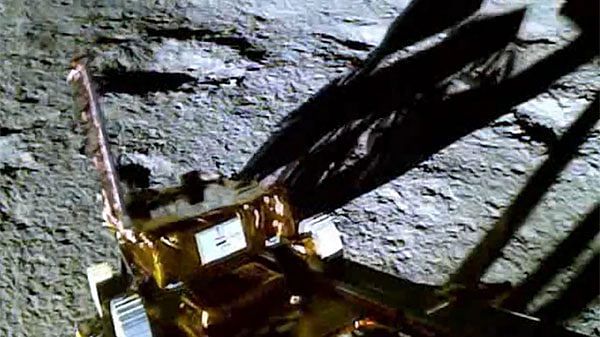Bengaluru: The Pragyan rover from Chandrayaan-3 had landed into a previously unknown and buried impact crater, likely one of the most ancient craters on the moon, scientists from the Physical Research Laboratory in Ahmedabad revealed on Monday.
Data from the rover has shown that the crater is ancient and significantly older than its neighbouring regions — most importantly, the South Pole Aitken (SPA) basin. The SPA basin lies 350 km away from where Chandrayaan-3’s Vikram Lander touched down on 23 August last year. The landing site has been named the Shiv Shakti Point.
The Vikram lander, which, along with the Pragyan rover, touched down on the lunar southern polar region that faces the Earth, has previously revealed the geological makeup of the impact craters surrounding it. More recently, a study of the visuals from the camera onboard the Pragyan rover revealed a crater’s rim around the Shiv Shakti Point.
Additionally, the in-situ analyses by the Pragyan rover showed this crater is more ancient than the areas around it and that materials from other impacts, including the one that created the SPA basin, covered and successfully hid this crater. “We used the NavCam (navigation camera) images from the Pragyan rover to identify nearby potential craters that could have contributed material to this one,” said lead author and associate professor at the Planetary Sciences division of Physical Research Laboratory, S. Vijayan.
Besides, the authors analysed overhead images from Chandrayaan-2, presently in orbit around the moon. In the photos taken by its Orbital High-Resolution Camera (OHRC), they found parallel groove-like structures in the south-eastern direction of the Vikram lander and similar small-scale features in the NavCam images of the Pragyan rover. Vijayan told ThePrint that these are the “constructive evidence” of material from distal or faraway craters “emplaced over the Chandrayaan-3 landing site”.
The findings were published in the journal Icarus this week and are helpful in the understanding of the evolution of the Moon’s southern pole region, which is expected to play host to future human missions due to the presence of water ice there.
Also Read: A satellite bus, new green space propulsion system & tech collabs unveiled at Bengaluru Space Expo
160 km wide, 4.4 km deep
The Vikram Lander became the first spacecraft to touch down safely on the Earth-facing southern polar region of the Moon, roughly 600 km from the lunar south pole.
Nearly 350km away from the rover towards the pole sits one of the largest and oldest impact craters in the solar system — the South Pole Aitken (SPA) basin.
Images from the Pragyan rover, which captured pictures of the landing site before it powered down, showed no boulders wider than 1m in the surrounding area — typical of the terrain.
The scientists subsequently found a semi-circular structure around the landing site and confirmed it to be the deformed rim of a buried crater over which the rover moved.
Further analysis by the Pragyan rover showed that materials foreign to the region covered the landing site. The data revealed materials from at least 11 nearby large basins and several small craters some kilometres wide.
“We did a best-fit circle around the preserved side of the crater and arrived at a ~160 km diameter for it. For a width of 160km, the crater should have a depth of roughly 4.4km,” explained Vijayan. “After this crater formed, its depression was filled with ejecta material from different craters over time. Specifically, the SPA basin ejecta material contributed to a thickness of ~1400 m.”
The crater below the Pragyan rover was covered primarily with materials that originated during the impact that created the SPA basin. The SPA basin is already considered one of the oldest impact craters in the solar system, dating back to 4.3-4.2 billion years ago. In 2019, China’s Chang’e-4 mission landed in the basin, followed by Chang’e-6 this year. Both landed on the far side of the Moon, facing away from the Earth.
The new findings show that the crater underneath the Shiv Shakti Point is even older and possibly one of the oldest geological regions on the moon. Apart from being covered by the ejected material from the SPA and nearby impacts, the scientists said, the newly found pre-SPA crater was erased by seismic shaking that those impacts triggered.
“Overall, Chandrayaan-3 landed within an ancient region that hosts some of the most deeply excavated materials on the Moon,” wrote the authors.
The findings answer questions about whether material from the landing region — revealed to be uniform recently, confirming the Moon contained a previous magma ocean — came from volcanic materials or surface processes such as impacts, with the latter emerging as the likelier scenario.
(Edited by Madhurita Goswami)
Also Read: Bellatrix Aerospace is rising with ISRO. Nano thrusters are its big game now

